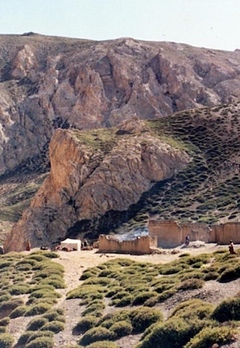Namkha Khyung Dzong Monastery in Tibet
A Brief Account of Namkha Khyung Dzong Monastery in Tibet
by Tulku Pema Rigtsal Rinpoche
The Snowy Land of Tibet is often described as being a land of ‘three liberations’, for it is said that the three provinces of Ngari in the west are liberated by their sacred sites; the four regions of Central Tibet in the middle are liberated by their sacred supports; and the six mountain ranges of Amdo and Kham in the east are liberated by their gurus.
The sacred site of Pal Drakmar Namkha Khyung Dzong lies in Ngari, at the head of the Maja Kabab (Karnali) river, next to Mount Kailash. It was established as a sacred practice place when the mahasiddha Chen-nga Lingpa practiced there in the past.
During Degyal Rinpoche’s time there, a large Dharma encampment was established, but no actual monastery or temple was built. Later on, Ajam Rinpoche and Serta Rinpoche, together with Lama Lopzang Nyima and others, joyfully took on the hardship of building a temple for the community of monks who lived there, as they could see how much it was needed. Through their efforts, and their great foresight, they succeeded in constructing a temple together with its inner shrine supports. This was an unsurpassable contribution to the Namkha Khyung Dzong tradition.
The Maja Kabab river is one of four great glacial rivers that spring forth from Mount Kailash. Namkha Khyung Dzong lies at the head of this river and is said to have three self-arisen gateways: an outer gateway, an inner gateway, and a secret gateway. At the outer gateway reside the white-robed long-haired practitioners of the two stages. At the inner gateway reside the community of saffron-robed monks, and to their left resides the community of venerable nuns. At the secret gateway lies Khandro Sangwé Shelpuk (Secret Crystal Cave of Ḍākinīs), the special cave where Kyapgön Degyal Rinpoche resided for seventeen years.
You can still see the remains of the old temple at the inner gateway, and, likewise, the remains of the temple housing Degyal Rinpoche’s Funeral Stupa, Ajam Rinpoche’s rooms, Degyal Rinpoche II’s residence, and the Hundred-Syllable Mantra Wheel. They were all destroyed during the terrible conflict of 1959.
Extracted from A Garland of White Lotuses: An Account of the Teaching and Teaching Holders of the Pal Drakmar Namkha Khyungdzong Tradition.
| Translated by Laura Swan, edited by Libby Hogg, 2021. First published on Lotsawa House, 2025.
Version: 1.0-20250117
